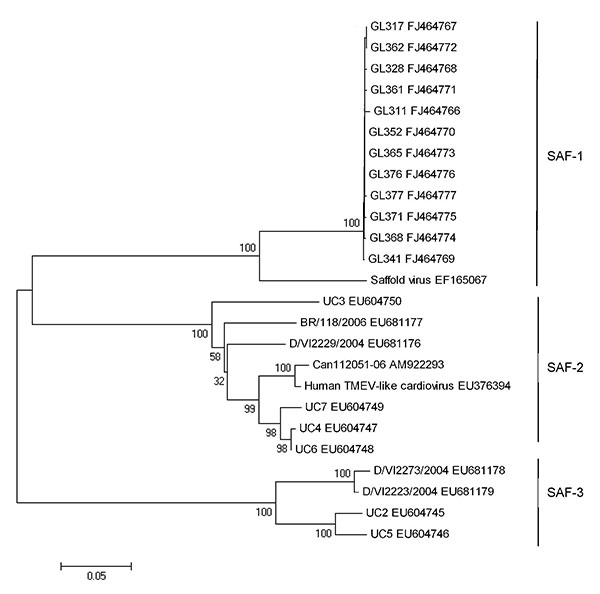Volume 15, Number 9—September 2009
Dispatch
Saffold Cardiovirus in Children with Acute Gastroenteritis, Beijing, China
Figure

Figure. Phylogenetic analysis of nucleotide sequences of the virus protein 1 (VP1) gene of Saffold cardiovirus. The tree was constructed by using the Molecular Evolutionary Genetics Analysis (MEGA) software version and the neighbor-joining algorithm with kimura-2 parameters (14). The analysis included human Theiler murine encephalomyelitis virus (TMEV)–like cardiovirus. TMEV-like cardiovirus sequences (GenBank accession no. EU376394) and the previously reported SAFV sequences including the prototype SAFV, U2-U7, Can112051-06, BR/118/2006, D/VI2229/2004, D/VI2223/2004, and D/VI2273/2004 (GenBank accession nos. EF165067, NC009448, EU604745-EU604750, AM922293, and EU681176-EU681179) as references. Because the sequences of SAFV-4 to SAFV-8 are not available, they are not included in the phylogenetic tree. Each strain from this study is indicated by a specific identification code (GL) followed by the patient number (GL311, GL317, GL328, GL341, GL352, GL361, GL362, GL365, GL368, GL371, GL376, and GL377) and its GenBank accession number. Scale bar indicates nucleotide substitutions per site.
References
- Jones MS, Lukashov VV, Ganac RD, Schnurr DP. Discovery of a novel human picornavirus in a stool sample from a pediatric patient presenting with fever of unknown origin. J Clin Microbiol. 2007;45:2144–50. DOIPubMedGoogle Scholar
- Stanway G, Brown F, Christian P, Hovi T, Hyypiä T, King AMQ, Family Picornaviridae. In: Fauquet CM, Mayo MA, Maniloff J, Desselberger U, Ball LA, editors. Virus taxonomy: eighth report of the International Committee on Taxonomy of Viruses. London: Elsevier/Academic Press; 2005. p. 757–78.
- LaRue R, Myers S, Brewer L, Shaw DP, Brown C, Seal BS, A wild-type porcine encephalomyocarditis virus containing a short poly (C) tract is pathogenic to mice, pigs, and cynomolgus macaques. J Virol. 2003;77:9136–46. DOIPubMedGoogle Scholar
- Knowles NJ, Dickinson ND, Wilsden G, Carra E, Brocchi E, De Simone F. Molecular analysis of encephalomyocarditis viruses isolated from pigs and rodents in Italy. Virus Res. 1998;57:53–62. DOIPubMedGoogle Scholar
- Grobler DG, Raath JP, Braak LE, Keet DF, Gerdes GH, Barnard BJ, An outbreak of encephalomyocarditis-virus infection in free-ranging African elephants in the Kruger National Park. Onderstepoort J Vet Res. 1995;62:97–108.PubMedGoogle Scholar
- Kirkland PD, Gleeson AB, Hawkes RA, Naim HM, Boughton CR. Human infection with encephalomyocarditis virus in New South Wales. Med J Aust. 1989;151:176–8.PubMedGoogle Scholar
- Liang Z, Kumar AS, Jones MS, Knowles NJ, Lipton HL. Phylogenetic analysis of the species Theilovirus: emerging murine and human pathogens. J Virol. 2008;82:11545–54. DOIPubMedGoogle Scholar
- Abed Y, Boivin G. New Saffold cardioviruses in 3 children, Canada. Emerg Infect Dis. 2008;14:834–6. DOIPubMedGoogle Scholar
- Drexler JF, Luna LK, Stöcker A, Almeida PS, Ribeiro TC, Petersen N, Circulation of 3 lineages of a novel Saffold cardiovirus in humans. Emerg Infect Dis. 2008;14:1398–405. DOIPubMedGoogle Scholar
- Chiu CY, Greninger AL, Kanada K, Kwok T, Fischer KF, Runckel C, Identification of cardioviruses related to Theiler's murine encephalomyelitis virus in human infections. Proc Natl Acad Sci U S A. 2008;105:14124–9. DOIPubMedGoogle Scholar
- Blinkova O, Kapoor A, Victoria J, Jones M, Wolfe N, Naeem A, Cardioviruses are genetically diverse and common enteric infections in south Asian children. J Virol. 2009;83:4631–41. DOIPubMedGoogle Scholar
- Rohayem J, Berger S, Juretzek T, Herchenröder O, Mogel M, Poppe M, A simple and rapid single-step multiplex RT-PCR to detect norovirus, astrovirus and adenovirus in clinical stool samples. J Virol Methods. 2004;118:49–59. DOIPubMedGoogle Scholar
- Chung JY, Han TH, Kim CK, Kim SW. Bocavirus infection in hospitalized children, South Korea. Emerg Infect Dis. 2006;12:1254–6.PubMedGoogle Scholar
- Tamura K, Dudley J, Nei M, Kumar S. MEGA4: Molecular Evolutionary Genetics Analysis (MEGA) software version 4.0. Mol Biol Evol. 2007;24:1596–9. DOIPubMedGoogle Scholar